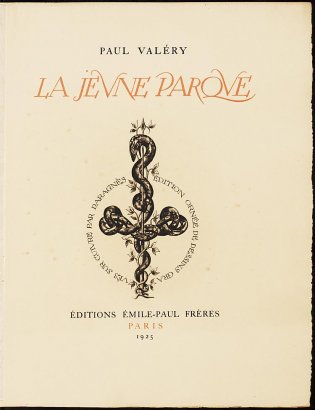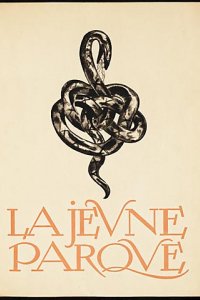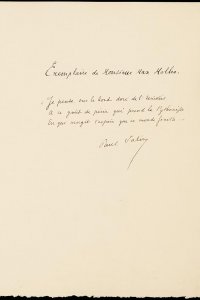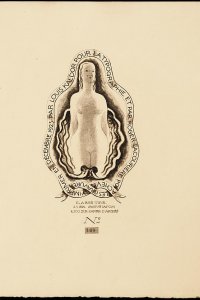La jeune Parque
Year: 1925
Author: Paul Valéry (1871 - 1945)
Artist: Jean-Gabriel Daragnès (1886 - 1950)
Publisher: Émile-Paul frères
This - later- edition of La jeune Parque was provided with etchings by Jean-Gabriel Daragnès, an artist who began his career as a painter, but who soon taught himself the art of engraving. His designs illustrate his love for the unity of the book. Not only did he illustrate books himself, but he was also active as a master printer and bibliophile. He gathered a circle of friends around him that consisted of writers such as Colette, Carco, Valéry, Mac Orlan and Giraudoux, artists such as Galanis, Bofa and Falké, and publisher Robert Émile-Paul. They came together on Saturdays in Daragnès's studio in Montmartre where various new projects and collaborations were initiated. La jeune Parque was the first title to be illustrated by Daragnès himself. The copy in the Koopman Collection is number 160 from a total of 200 copies printed on Arches paper, and it contains a dedication from Valéry to Max Molho as well as a manuscript correction by the author, which he signed with his initials.
Bibliographical description
Description: La jeune Parque / Paul Valéry ; éd. ornée de dess. grav. sur cuivre par Daragnès. - Paris : Émile-Paul frères, 1925. - [52] p. : ill. ; 33 cm
Printer: Louis Kaldor (tekst) Roger Lacourière (etsen)
Edition: 225 copies
This copy: Number 160 of 200 on Arches
Note: With autograph dedication from the author to Max Molho
Note: With manuscript correction by the author, signed with his initials
Bibliography: Bénézit 4-242 ; Carteret IV-386 ; Édouard-Joseph I-350 ; Monod 10884
Shelfmark: KW Koopm A 571
References
- Sylvie Ballestra-Puech, Lecture de La jeune Parque. Paris, Klincksieck, 1993
- Marie-Louis Bataille, 'Gabriel Daragnès, graveur et maître d’oeuvre', in: Art et décoration, 64 (1935), p. 104-112
- Maurice Bémol, La parque et le serpent: essai sur les formes et les mythes. Paris, Les Belles Lettres, 1955
- Denis Bertholet, Paul Valéry 1871-1945. Paris, Plon, 1995
- Paul van Capelleveen, Sophie Ham, Jordy Joubij, Voices and visions. The Koopman Collection and the Art of the French Book. The Hague, Koninklijke Bibliotheek, National Library of the Netherlands; Zwolle, Waanders, 2009
- Paul van Capelleveen, Sophie Ham, Jordy Joubij, Voix et visions. La Collection Koopman et l'Art du Livre français. La Haye, Koninklijke Bibliotheek, Bibliothèque nationale des Pays-Bas; Zwolle, Waanders, 2009



![La jeune parque, pagina [7] met ets door Jean-Gabriel Daragnès](/sites/default/files/styles/galerie/public/images/la-jeune-parque-p7.jpg?h=916ab959&itok=0pZLzu-t)
![La jeune parque, pagina [33] met ets door Jean-Gabriel Daragnès](/sites/default/files/styles/galerie/public/images/la-jeune-parque-p33.jpg?h=b203db40&itok=M_FgbLWI)
![La jeune parque, pagina [35] met correctie in handschrift door Paul Valéry](/sites/default/files/styles/galerie/public/images/la-jeune-parque-p35.jpg?h=825eb4f8&itok=suR3Mxux)
